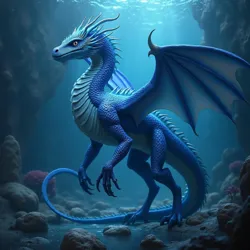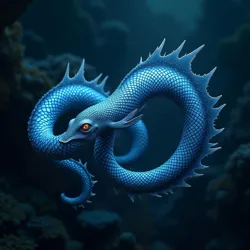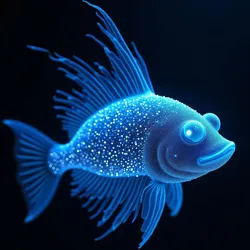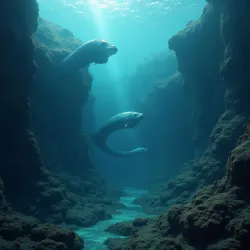Aquamarina Volans: Serpentine Sovereigns of the Depths

Aquamarina Volans, also known as Abyssal Serpents, elemental dragons inhabiting Dracona's Aquamarina Depths and apex predators of the oceanic biomes.
Aquamarina Volans
Abyssal Serpents
Dracona
Aquamarina Depths
30-50 meters
70+ meters
Apex predator
Bioluminescence
Aquamarina Volans, frequently referred to as Abyssal Serpents by early explorers, are a species of elemental dragon native to the Aquamarina Depths of the planet Dracona. These magnificent creatures are the apex predators of Dracona's vast oceanic biomes, embodying the essence of water in their fluid forms and mastery of the deep. Distinguished by their serpentine bodies, bioluminescent patterns, and profound adaptations to the crushing pressures and frigid temperatures of the abyssal zones, Aquamarina Volans are a keystone species in the intricate ecosystems of Dracona's polar oceans and deep-sea trenches.
Overview
Aquamarina Volans represent the pinnacle of aquatic adaptation among Dracona's dragon inhabitants. Unlike their terrestrial, aerial, or volcanic counterparts, Aquamarina Volans have evolved to dominate the vast, three-dimensional realm of Dracona's oceans. Their lithe, serpentine bodies are perfectly suited for navigating the dense aquatic medium, allowing for both powerful propulsion and intricate maneuvering through complex underwater environments. These dragons are not merely inhabitants of the ocean; they are integral to its structure and function, influencing nutrient cycles, regulating prey populations, and even contributing to the unique chemical composition of the Aquamarina Depths through their bioluminescent secretions and metabolic processes.
 Serpentine body of an Aquamarina Volans with iridescent azure scales, bioluminescent patterns, and streamlined form for deep-sea pressures.
Serpentine body of an Aquamarina Volans with iridescent azure scales, bioluminescent patterns, and streamlined form for deep-sea pressures.Physical Characteristics
Aquamarina Volans are characterized by their elongated, serpentine bodies, which can reach impressive lengths, with mature adults averaging between 30 to 50 meters, and exceptionally large individuals documented to exceed 70 meters. Their bodies are streamlined and muscular, allowing for swift and agile movement through water. Unlike the winged forms of Ventus Dragons or the quadrupedal builds of Terran Dragons, Aquamarina Volans lack prominent limbs, instead relying on powerful lateral undulations of their bodies and a broad, paddle-like tail for propulsion. Small, vestigial fins run along their flanks and tail, providing additional stability and fine control in the water.
Their scales are smooth and overlapping, providing a flexible yet protective covering. The coloration of Aquamarina Volans scales is predominantly a deep, iridescent azure, ranging from sapphire to cobalt, which provides excellent camouflage in the dimly lit depths. Scattered across their bodies are complex patterns of bioluminescent organs, known as photophores. These photophores emit a soft, ethereal glow, typically in shades of blue, green, and violet, creating intricate and dynamic light displays that serve various purposes, including communication, camouflage, and attracting prey. The intensity and pattern of bioluminescence can be modulated, allowing for a sophisticated form of visual signaling in the darkness of the deep ocean.
The head of an Aquamarina Volans is relatively small and streamlined, with large, forward-facing eyes adapted for low-light vision. These eyes possess an exceptional capacity for light gathering and are highly sensitive to bioluminescent emissions, enabling them to navigate and hunt effectively in the near-total darkness of the abyssopelagic zone. They possess a series of sensory barbels around their jaws and snout, which are chemosensory organs capable of detecting minute chemical gradients in the water, aiding in prey location and navigation in turbid or dark environments. Their jaws are lined with rows of sharp, backward-curving teeth, ideally suited for grasping and holding slippery prey.
Habitat and Distribution
Aquamarina Volans are primarily found throughout the Aquamarina Depths, Dracona's expansive polar oceans that extend into deep-sea trenches and abyssal plains. Their distribution spans from the sunlit epipelagic zone near the surface to the crushing depths of the abyssopelagic zone, over 8,000 meters below sea level. They are particularly abundant in regions characterized by hydrothermal vent activity, such as the Serpent's Spine Ridge, a newly discovered underwater volcanic mountain range within the Aquamarina Depths. Hydrothermal vents provide a unique oasis of warmth and chemical energy in the otherwise frigid and nutrient-poor deep ocean, supporting chemosynthetic ecosystems that form the base of the food web for Aquamarina Volans.
While predominantly deep-sea creatures, Aquamarina Volans are known to ascend to shallower waters, particularly during nocturnal hunts or seasonal migrations. Juveniles and smaller individuals may be more frequently encountered in mesopelagic and bathypelagic zones, where food resources may be more readily available and predation pressure from larger adults is reduced. Their global distribution across the Aquamarina Depths is facilitated by deep ocean currents, which allow for dispersal and gene flow between geographically separated populations. However, distinct regional variations in bioluminescent patterns and subtle morphological traits suggest some degree of population structuring and local adaptation within different oceanic basins.
Diet and Hunting Behavior
Aquamarina Volans are apex predators in the Aquamarina Depths ecosystem, occupying the highest trophic level in the oceanic food web. Their diet is diverse and opportunistic, encompassing a wide range of prey items, from large pelagic fish and giant squid to deep-sea crustaceans and even smaller marine reptiles. They are formidable and efficient hunters, employing a combination of ambush tactics, pursuit predation, and sensory deception to secure their prey.
In the dimly lit mesopelagic zone and sunlit epipelagic zone, Aquamarina Volans often utilize ambush predation, relying on their cryptic coloration and bioluminescent camouflage to blend seamlessly with the surrounding environment. They may lie in wait near underwater structures, kelp forests, or convergences of ocean currents, patiently awaiting unsuspecting prey to approach. Once prey is within striking distance, they launch a rapid and powerful attack, using their muscular bodies to generate bursts of speed and their sharp teeth to seize and subdue their targets.
In the perpetually dark bathypelagic and abyssopelagic zones, Aquamarina Volans rely more heavily on their sensory adaptations and bioluminescent lures to hunt. Their highly sensitive eyes and chemosensory barbels allow them to detect the faintest bioluminescent flashes or chemical trails emitted by potential prey. They may use their own bioluminescence to create attractive displays, mimicking the light patterns of smaller prey organisms to lure unsuspecting victims closer. Some Aquamarina Volans have been observed using coordinated bioluminescent flashes to disorient schools of fish or cephalopods, making them easier to capture. Their powerful jaws and constricting bodies enable them to subdue even large and heavily armored prey in the crushing depths.
Biology and Physiology
The biology and physiology of Aquamarina Volans are characterized by a suite of remarkable adaptations to the extreme conditions of the deep ocean environment. Their bodies are built to withstand immense hydrostatic pressure, frigid temperatures, and near-total darkness, while maintaining efficient metabolic processes and complex sensory capabilities. These dragons represent a fascinating example of evolutionary specialization in response to a challenging and unique ecological niche.
 Aquamarina Volans utilizing bioluminescence for communication and hunting, showcasing intricate light patterns from photophores in the dark ocean depths.
Aquamarina Volans utilizing bioluminescence for communication and hunting, showcasing intricate light patterns from photophores in the dark ocean depths.Bioluminescence
Bioluminescence is perhaps the most striking and defining physiological feature of Aquamarina Volans. Their bodies are adorned with thousands of photophores, specialized light-emitting organs embedded within their scales and skin. These photophores contain bioluminescent chemicals, primarily luciferin and luciferase, which react to produce light through a process known as bioluminescence. The light emitted by Aquamarina Volans is typically blue-green, the wavelengths of light that travel furthest in water, making it effective for communication and signaling in the deep ocean.
The bioluminescence of Aquamarina Volans serves a multitude of functions. As mentioned previously, it plays a crucial role in hunting, acting as a lure to attract prey and as camouflage to blend with the faint ambient light filtering down from the surface or the bioluminescent displays of other deep-sea organisms. It is also essential for intraspecific communication, allowing individuals to recognize each other, establish social hierarchies, and coordinate mating rituals in the vast and dark ocean. Complex patterns of flashing and modulated light emissions are used to convey information about identity, reproductive status, and territorial claims.
Furthermore, the bioluminescent secretions of Aquamarina Volans are known to possess unique chemical properties. Studies by the Explorers of the Obsidian Eye have revealed that these secretions contain compounds with potent antimicrobial and antioxidant properties. It is hypothesized that these secretions may play a role in maintaining skin health in the harsh deep-sea environment and potentially have applications in Draconian bio-technology.
Sensory Adaptations
Aquamarina Volans possess a suite of highly refined sensory adaptations that enable them to thrive in the low-light, high-pressure environment of the deep ocean. Their vision is optimized for low-light conditions, with large pupils, a high density of rod cells in their retinas, and the presence of light-sensitive pigments that are maximally sensitive to blue-green light. This allows them to detect even faint bioluminescent flashes and silhouettes against the dark background of the deep sea.
In addition to their exceptional vision, Aquamarina Volans rely heavily on chemoreception and mechanoreception. Their sensory barbels, located around their mouths and snout, are highly sensitive to dissolved chemicals in the water, allowing them to detect the scent trails of prey, locate hydrothermal vents, and navigate complex chemical landscapes. Lateral line organs, running along their flanks, are sensitive to pressure changes and vibrations in the water, providing them with a sense of "distant touch" that helps them to detect the movements of prey and predators, even in complete darkness. These sensory systems, working in concert, provide Aquamarina Volans with a comprehensive awareness of their surroundings in the challenging deep-sea environment.
Reproduction and Lifecycle
The reproductive biology of Aquamarina Volans is still under investigation, but current observations suggest a complex lifecycle adapted to the deep-sea environment. They are believed to be ovoviviparous, meaning that females retain fertilized eggs internally until they hatch, giving birth to live young. This reproductive strategy may be advantageous in the deep ocean, where egg deposition on the seafloor could be risky due to predation and harsh environmental conditions.
Mating rituals are thought to involve elaborate bioluminescent displays, with males and females engaging in synchronized flashing patterns to attract mates and establish pair bonds. The gestation period is likely to be lengthy, possibly lasting several years, reflecting the slow metabolic rates and resource limitations of the deep-sea environment. Litter sizes are relatively small, typically consisting of a few dozen offspring, ensuring a higher level of parental investment in each individual offspring.
Juvenile Aquamarina Volans are initially pelagic, inhabiting shallower waters in the mesopelagic zone, where they feed on smaller prey and grow rapidly. As they mature, they gradually descend into deeper waters, eventually reaching the bathypelagic and abyssopelagic zones as adults. Lifespans are estimated to be exceptionally long, potentially exceeding several centuries, reflecting their slow growth rates and the stability of their deep-sea habitat.
Ecology and Behavior
Aquamarina Volans play a crucial role in the ecology of the Aquamarina Depths, functioning as apex predators and ecosystem engineers. Their presence influences the structure and function of deep-sea communities, regulating prey populations, mediating nutrient cycling, and shaping the distribution of other species. Their behavior is intricately linked to their ecological role, reflecting adaptations to the unique challenges and opportunities of the deep-sea environment.
Social Structure
Aquamarina Volans are generally solitary creatures, particularly as adults, maintaining vast individual territories in the deep ocean. Territoriality is likely driven by the need to secure sufficient food resources and reduce competition in the sparsely populated deep-sea environment. Interactions between adults are primarily limited to mating season and occasional territorial disputes.
However, younger Aquamarina Volans, particularly juveniles and sub-adults, may exhibit more gregarious behavior. Loose aggregations of younger individuals have been observed in shallower waters, potentially for cooperative foraging or enhanced predator avoidance. These aggregations are temporary and dissolve as individuals mature and disperse into deeper waters to establish their own territories.
Communication among Aquamarina Volans is primarily visual, relying on their sophisticated bioluminescent signaling system. Complex patterns of flashing, pulsing, and modulated light emissions are used to convey a range of information, from individual recognition and territorial displays to mating signals and alarm calls. Chemical communication may also play a role, particularly in long-range signaling and territory marking, but visual communication is dominant in their social interactions.
Role in the Aquamarina Depths Ecosystem
As apex predators, Aquamarina Volans exert top-down control over the food web of the Aquamarina Depths. They regulate populations of their prey species, preventing any single species from becoming dominant and maintaining the overall biodiversity of the ecosystem. Their predation pressure can influence the behavior and distribution of prey species, shaping community structure and dynamics.
Aquamarina Volans also play a role in nutrient cycling within the deep ocean. By feeding on organisms at various trophic levels, they redistribute nutrients throughout the water column. Their fecal matter and carcasses, when they die, sink to the seafloor, providing a source of organic matter for benthic communities, linking the pelagic and benthic realms of the deep ocean. Their movements and feeding activities can also stir up sediments, releasing nutrients from the seafloor and further contributing to nutrient cycling.
Furthermore, Aquamarina Volans contribute to the unique chemical environment of the Aquamarina Depths through their bioluminescent secretions. As mentioned earlier, these secretions contain antimicrobial and antioxidant compounds, which may influence microbial communities and chemical processes in their surroundings. The precise ecological significance of these secretions is still being investigated, but they highlight the intricate ways in which Aquamarina Volans are integrated into their environment.
Interactions with Other Species
Aquamarina Volans interact with a diverse array of other species in the Aquamarina Depths, both as predators and as components of a complex ecological web. They prey on numerous species of fish, cephalopods, crustaceans, and other marine invertebrates, as well as occasional smaller marine reptiles. Their presence as apex predators influences the evolutionary trajectories of their prey species, driving adaptations for predator avoidance and defense.
While Aquamarina Volans are apex predators in most contexts, they may occasionally face threats from even larger marine organisms, although such encounters are likely rare. Juvenile Aquamarina Volans may be vulnerable to predation from larger fish, sharks, or marine reptiles, highlighting the importance of rapid growth and maturation in their early life stages.
They also interact with symbiotic species, such as bioluminescent bacteria that may contribute to their light-emitting capabilities, and potentially with commensal or parasitic organisms that live on or within their bodies. The full extent of their interspecies interactions is still being explored, but it is clear that Aquamarina Volans are embedded within a rich and complex network of ecological relationships in the Aquamarina Depths.
Aquamarina Volans and the Explorers of the Obsidian Eye
The discovery of Dracona and its elemental dragons by the Explorers of the Obsidian Eye has opened up new avenues for understanding the biology, ecology, and evolution of Aquamarina Volans. Initial observations and ongoing research by the explorers are providing unprecedented insights into these magnificent deep-sea dragons and their unique adaptations.
 Aquamarina Volans in their deep-sea habitat, potentially near hydrothermal vents like the Serpent's Spine Ridge, distributed from surface to abyssal zones.
Aquamarina Volans in their deep-sea habitat, potentially near hydrothermal vents like the Serpent's Spine Ridge, distributed from surface to abyssal zones.Initial Observations
The first observations of Aquamarina Volans by the Explorers of the Obsidian Eye were conducted remotely from the Umbral Voyager, utilizing advanced sonar and bioluminescence detection technologies. These initial scans revealed the presence of large, serpentine organisms inhabiting the Aquamarina Depths, emitting distinctive bioluminescent signatures. Unmanned submersible probes were subsequently deployed to obtain closer-range observations and collect data on their morphology, behavior, and physiology.
These probes captured stunning visual recordings of Aquamarina Volans in their natural habitat, revealing their elegant serpentine forms, intricate bioluminescent patterns, and formidable predatory capabilities. Samples of seawater and sediment collected near Aquamarina Volans habitats were analyzed, revealing the unique chemical composition of their bioluminescent secretions and providing clues about their metabolic processes. The explorers were particularly intrigued by the sophistication of their bioluminescent communication system and their apparent intelligence and complex social behaviors.
Ongoing Studies
Ongoing research by the Explorers of the Obsidian Eye focuses on non-invasive observation and ethical data collection, aiming to minimize any disturbance to Aquamarina Volans and their deep-sea ecosystems. Autonomous underwater vehicles (AUVs) equipped with advanced sensors and cameras are being deployed to track Aquamarina Volans movements, monitor their social interactions, and study their feeding ecology. Xenolinguists are analyzing their bioluminescent communication signals, attempting to decipher their meaning and complexity.
Physiological studies are being conducted on samples of bioluminescent secretions and shed scales collected by the probes, investigating their chemical properties and potential applications in Draconian bio-technology. Environmental specialists are studying the role of Aquamarina Volans in the Aquamarina Depths ecosystem, assessing their impact on prey populations, nutrient cycling, and community structure. Ethical guidelines are strictly adhered to throughout all research activities, ensuring that the well-being and autonomy of Aquamarina Volans are prioritized.
Cultural Significance: Lumiflora Craft of the Abyssal Nymphs
The unique bioluminescence of Aquamarina Volans has not only captivated the scientific interest of the Explorers of the Obsidian Eye but has also inspired a nascent form of artistic and technological appreciation among them, leading to the development of Lumiflora Craft. While the Explorers maintain a strict non-interference policy with Draconian ecosystems, the mesmerizing light displays of Aquamarina Volans have prompted them to explore synthetic bioluminescence for their own purposes.
Inspired by the dragons’ natural artistry, certain Explorer factions, particularly those with a leaning towards aesthetics and bio-engineering, have begun to cultivate bioluminescent flora within their research outposts and aboard the Umbral Voyager. This practice, termed Lumiflora Craft, involves genetically modifying deep-sea flora from Dracona – specifically varieties of abyssal kelp and luminescent fungi gathered by unmanned probes – to enhance and diversify their bioluminescent properties. These cultivated flora are then arranged into intricate, living light sculptures within contained environments.
These Lumiflora installations are not merely decorative; they serve as dynamic displays of light and color, mimicking the complex communication patterns and environmental interactions observed in Aquamarina Volans. Explorers use these living light gardens for relaxation, meditation, and even as a form of subtle communication amongst themselves, drawing parallels between their engineered ecosystems and the natural wonders of Dracona’s deep oceans. The study of Aquamarina Volans bioluminescence has thus fostered a unique cultural expression within the Explorers of the Obsidian Eye, demonstrating how the observation of alien life can inspire creativity and innovation in unexpected ways. Further exploration of Lumiflora Craft and its cultural significance can be found in the dedicated article: Lumiflora Craft of the Abyssal Nymphs.